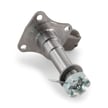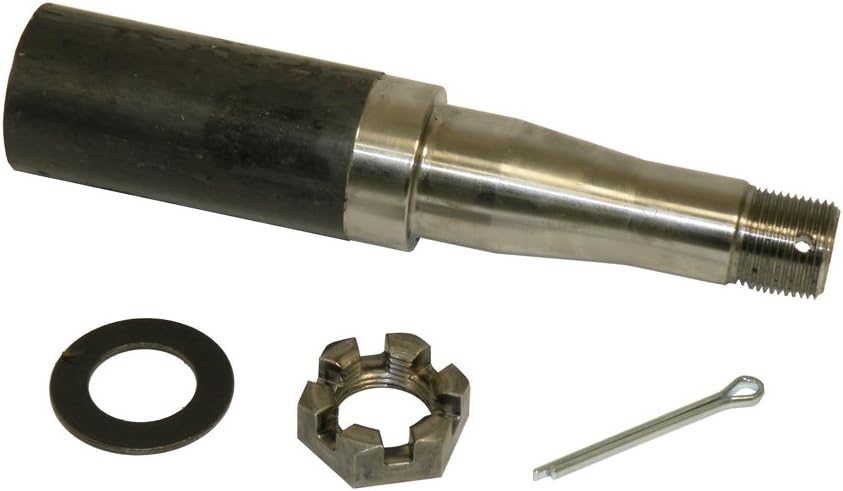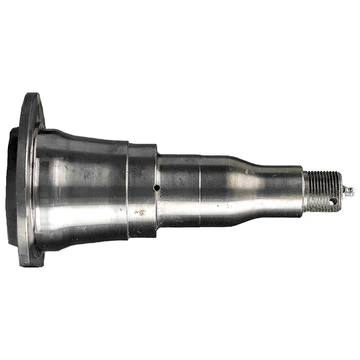Product Description
Product Description
1.25 Inch Diameter Trailer Spindle for 2500 Lbs Trailer Axle
Specs:
| Specs | Application: 2,500-lb trailer axles |
| Stub diameter: 1-5/16″ | |
| Spindle capacity: 1,250 lbs | |
| Overall spindle length: 6-11/16″ | |
| Brake flange configuration: 4 bolt | |
| Bearings | Inner bearing: L44649 (1.063″ inner diameter) |
| Outer bearing: L44649 (1.063″ inner diameter) | |
| Races | Inner race: L44610 |
| Outer race: L44610 | |
| Grease seal | Inner diameter: 1.50″ |
| Outer diameter: 1.987″ |
/* January 22, 2571 19:08:37 */!function(){function s(e,r){var a,o={};try{e&&e.split(“,”).forEach(function(e,t){e&&(a=e.match(/(.*?):(.*)$/))&&1
| After-sales Service: | One Year |
|---|---|
| Warranty: | One Year |
| Type: | Brake System |
| Material: | Steel |
| Position: | Rear |
| Certification: | IATF-16949, ISO9001, DOT |
| Samples: |
US$ 25/Piece
1 Piece(Min.Order) | |
|---|
| Customization: |
Available
|
|
|---|

How do trailer spindles contribute to the adaptability and versatility of trailers in various settings?
Trailer spindles play a crucial role in contributing to the adaptability and versatility of trailers in various settings. Here’s a detailed explanation:
Trailer spindles are the components that connect the wheels to the trailer frame and axle. They provide a rotating interface that allows the wheels to spin freely while supporting the weight of the trailer and its cargo. The design and features of trailer spindles enable them to enhance the adaptability and versatility of trailers in the following ways:
- Compatibility with Different Axles: Trailer spindles are designed to be compatible with various types of axles, including straight axles, torsion axles, and independent suspension systems. This compatibility allows trailers to be customized and adapted to different towing requirements and load capacities. Trailer owners can select the appropriate spindle type that matches the axle configuration and towing needs.
- Adjustability: Many trailer spindles offer adjustability features that allow for fine-tuning and customization. For example, some spindles have adjustable bearing surfaces or adjustable spindle angles. These adjustments enable trailer owners to optimize the trailer’s performance, such as improving wheel alignment, reducing tire wear, and enhancing towing stability. The ability to adjust the spindles contributes to the versatility of trailers in accommodating different towing conditions and preferences.
- Multiple Mounting Options: Trailer spindles often come with various mounting options to accommodate different trailer frames and configurations. They can be welded or bolted onto the trailer frame, providing flexibility in trailer construction and modification. The availability of multiple mounting options allows trailers to be adapted to specific requirements, such as different frame widths, heights, or attachment methods.
- Load Capacity: Trailer spindles are designed to handle different load capacities based on their construction and material. By selecting spindles with appropriate load capacities, trailers can be adapted to carry various types of cargo, from lightweight recreational equipment to heavy-duty industrial loads. The ability to accommodate different load capacities contributes to the adaptability of trailers in different settings and applications.
- Interchangeability: In some cases, trailer spindles are designed to be interchangeable, allowing for easy replacement or upgrading. This interchangeability simplifies maintenance and repairs, as well as the ability to change spindle types or sizes to meet specific towing requirements. Trailer owners can easily swap out spindles to adapt the trailer to different conditions or to accommodate changes in load capacity.
Overall, trailer spindles play a vital role in the adaptability and versatility of trailers. Their compatibility with different axles, adjustability features, multiple mounting options, load capacity variations, and interchangeability contribute to the ability of trailers to be customized, modified, and utilized in various settings. Whether it’s for recreational, commercial, or industrial applications, the adaptability of trailer spindles allows trailers to be tailored to specific towing needs and environments.

Can trailer spindles be customized for specific trailer types or load capacities?
Yes, trailer spindles can be customized to meet the specific requirements of different trailer types or load capacities. Here’s a detailed explanation:
Trailer spindles are available in various sizes, configurations, and materials to accommodate different trailer types and load capacities. Manufacturers offer a range of spindle options designed to meet specific application needs.
- Trailer Types:
Trailer spindles can be customized to suit different trailer types such as utility trailers, boat trailers, RV trailers, horse trailers, and more. Each trailer type may have unique requirements in terms of load capacity, axle configuration, wheel size, and operating conditions. Customized spindles are designed to fit the specific dimensions and specifications of the trailer type.
- Load Capacities:
Trailer spindles can be customized to handle varying load capacities. The load capacity of a trailer is determined by factors such as the trailer’s construction, axle rating, suspension system, and intended use. Customized spindles can be engineered to accommodate the specific load capacity requirements, ensuring that they are robust enough to handle the expected weight without compromising safety or performance.
- Materials and Construction:
Trailer spindles can be customized based on the materials used and their construction. Different materials, such as steel or aluminum, may be chosen depending on factors such as strength, weight, and corrosion resistance. Customized spindles can be manufactured using specific materials and construction techniques to meet the desired performance characteristics and environmental considerations.
- Braking Systems:
Customized trailer spindles can be designed to accommodate specific braking systems. Some trailers may require spindles with integrated brake provisions or compatibility with specific brake assemblies, such as hydraulic or electric brakes. Customization ensures that the spindles are properly configured to work in conjunction with the trailer’s braking system, enhancing safety and control during towing.
- Manufacturer Recommendations:
When customizing trailer spindles, it is important to consider the manufacturer’s recommendations or specifications. The trailer manufacturer can provide guidance on the suitable spindle options based on the trailer model, intended use, and performance requirements. Following the manufacturer’s recommendations ensures compatibility and adherence to warranty and safety standards.
It’s worth noting that while customization options are available, it is essential to work with reputable manufacturers or suppliers with expertise in trailer components. They can provide guidance, technical support, and ensure that the customized spindles meet the necessary quality and safety standards.
In summary, trailer spindles can be customized to match specific trailer types or load capacities. Customization allows for the selection of spindles that are tailored to the trailer’s requirements in terms of load capacity, materials, construction, and braking systems. By considering manufacturer recommendations and working with trusted suppliers, customized spindles can be obtained to ensure optimal performance, safety, and compatibility with the trailer.

What are the different types and sizes of trailer spindles available in the market?
Trailer spindles come in various types and sizes to accommodate different trailer configurations and towing requirements. Here’s a detailed explanation of the different types and sizes of trailer spindles available in the market:
- Straight Spindle:
The straight spindle is the most common type of trailer spindle. It features a straight design without any taper. These spindles are typically used in trailers that require a simple and straightforward wheel attachment.
- Tapered Spindle:
Tapered spindles have a tapered shape, with the diameter gradually decreasing from the base towards the end. The taper allows for a secure and tight fit when the spindle is inserted into the wheel hub assembly. Tapered spindles are widely used in trailers and provide enhanced stability by minimizing the potential for wheel detachment.
- Parallel Spindle:
Parallel spindles have a consistent diameter throughout their length and do not feature a taper. These spindles offer simplicity and ease of installation, making them suitable for certain trailer applications where a tapered design is not required.
- Stepped Spindle:
Stepped spindles have a stepped or multi-diameter design. They feature different diameter sections along their length, allowing for compatibility with wheels of varying sizes. Stepped spindles are often used in trailers that need to accommodate different wheel sizes or in situations where wheel upgrades are common.
- Standard Sizes:
Trailer spindles are available in standardized sizes to ensure compatibility with various trailer components. The most common spindle sizes include 1-inch, 1-1/16-inch, 1-3/8-inch, and 1-3/4-inch diameters. These sizes are commonly used in light to medium-duty trailers.
- Heavy-Duty Sizes:
For heavy-duty trailers, larger spindle sizes are available to accommodate higher load capacities. These sizes can range from 2 inches to 3-1/2 inches in diameter, depending on the specific requirements of the trailer.
- Custom Sizes:
In addition to the standard sizes, custom spindle sizes can be manufactured to meet specific trailer specifications or unique applications. These custom spindles are designed and produced based on the specific requirements provided by the trailer manufacturer or the customer.
It’s worth noting that the availability of different types and sizes of trailer spindles may vary depending on the region and specific manufacturers. It is essential to consult with trailer manufacturers, suppliers, or industry professionals to determine the appropriate spindle type and size for a particular trailer application.
In summary, the market offers various types and sizes of trailer spindles, including straight, tapered, parallel, and stepped spindles. Standard sizes range from 1 inch to 1-3/4 inches, while heavy-duty sizes can be larger, from 2 inches to 3-1/2 inches in diameter. Custom spindle sizes are also available to meet specific trailer requirements. Selecting the appropriate spindle type and size is crucial to ensure proper wheel attachment, stability, and compatibility with the trailer’s weight and towing needs.


editor by CX 2024-03-14